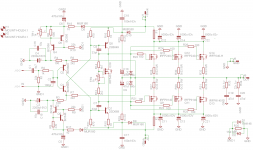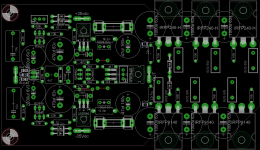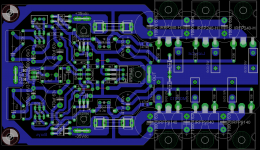Marc
If you have some JFet at home you can test it by replacing the BC550C/560C
For BC550C use 2SK170BL and BC560C use 2SJ74BL Just rotate them 180 degree to solder them to the PC board.
For example if the two BJT was face to face the JFet has to be back to back
I used between 7-8mA but I don't think that is so important as long as U chose BL grade.
Greetings G
If you have some JFet at home you can test it by replacing the BC550C/560C
For BC550C use 2SK170BL and BC560C use 2SJ74BL Just rotate them 180 degree to solder them to the PC board.
For example if the two BJT was face to face the JFet has to be back to back
I used between 7-8mA but I don't think that is so important as long as U chose BL grade.
Greetings G
Aside from the kind of cap used, do you have any idea why that might be? I tried Shaan's version of the VSSA with and without an input cap, different caps, and there seemed to be little or no difference, at least I thought that at the time. Am I missing something about the input circuit?I think that someone try input cap with LC VSSA and didnt like the sound. That capacitor has influence on signal path, has its own sonic character... 🙂
(I did not test w. LC's modules the same way)
I dont know realy... U should ask that guy, i will try to found the post. But, do you hear differences between stranded wire and solid core wire?
It seems that I am one of the few people that actually more like amps that have input cap than the same amp without it (DC coupled). It is true that there is some phase distortion with the cap but if you consider how much speakers and passive crossovers influence phase distortion, the contribution of input cap is negligible. In fact good quality electrolitic caps sound to me even better than the best polypropilene caps. I remember one National Semiconductor app. note where they claimed that critical listeners found that even the best film caps caused degradation of sound in power amps but I never found that. With input cap the sound is somewhat cleaner and crisper, without it you have more overblown low end and that I do not like. Too massive bass can ruin the sound.
Idefixes, since you live in France, I can recommend to you excellent loudspeaker cable: Triangle TC 2250. That is my favourite reasonably priced loudspeaker cable. My reference stranded cable!
Idefixes, since you live in France, I can recommend to you excellent loudspeaker cable: Triangle TC 2250. That is my favourite reasonably priced loudspeaker cable. My reference stranded cable!
Last edited:
I don't think I ever tried a test like that... sorry 😱I dont know realy... U should ask that guy, i will try to found the post. But, do you hear differences between stranded wire and solid core wire?
It seems that I am one of the few people that actually more like amps that have input cap than the same amp without it (DC coupled). It is true that there is some phase distortion with the cap but if you consider how much speakers and passive crossovers influence phase distortion, the contribution of input cap is negligible. In fact good quality electrolitic caps sound to me even better than the best polypropilene caps. QUOTE]
I agree with that
If I can afford I use BG NP type. To me better than any poly or other type foil ever tried.
It give some sweetness to the sound. Like a good buffer.
Without caps sometimes to dry also you have to watch for the DC from your source or preamp.
Of course if you like it with out caps use it that way.
Do not forget capacitors has break in time. Sometimes if you use a new caps on the input take very long period to break in.
Usually I use that cap somewhere at PS or higher voltage before I ad to the input.
On the input really hard to break in the cap because low (signal)voltage.
Greetings G
gaborbela,
I agree with you concerning elcos at the input. With film caps I think it is important how you orient them. Although they are not polarized like elcos, their sound depends on how they are wound, in one way there is less noise picked. Recently Sakis reported that some Thomson film caps at the input sounded better when two are connected in parallel but in the opposite direction!
Bottom line is that this topic is strongly dependent on taste. If one feels that input caps degrade the sound then caps should be removed.
I agree with you concerning elcos at the input. With film caps I think it is important how you orient them. Although they are not polarized like elcos, their sound depends on how they are wound, in one way there is less noise picked. Recently Sakis reported that some Thomson film caps at the input sounded better when two are connected in parallel but in the opposite direction!
Bottom line is that this topic is strongly dependent on taste. If one feels that input caps degrade the sound then caps should be removed.
It seems that I am one of the few people that actually more like amps that have input cap than the same amp without it (DC coupled). It is true that there is some phase distortion with the cap but if you consider how much speakers and passive crossovers influence phase distortion, the contribution of input cap is negligible. In fact good quality electrolitic caps sound to me even better than the best polypropilene caps. I remember one National Semiconductor app. note where they claimed that critical listeners found that even the best film caps caused degradation of sound in power amps but I never found that. With input cap the sound is somewhat cleaner and crisper, without it you have more overblown low end and that I do not like. Too massive bass can ruin the sound.
QUOTE]
I think it is beatiful with different views, boring and machine-like if we all do the same, so here is oposit.
My system is total DC-coupled without "massive bass that ruin the sound" as said.
All wires solidcore and one way sealed speaker with EQ in digital domain linearfase but only low SPL because of EQ in low end. When high SPL go two way with same EQ in digital domain with linearfase which also handles crossover. When running one way speaker it sounds pure, nears headphone-like. In one way mode there is technical only phase errors by the speaker and the 12dB highpass filter by the Sealed box, so nice Group delay. But cant play a squarewave correct from speaker even tho, but would be possible if one follow another thread here.
System is cheap nearly all diy.
Teaser about multicore and something to Wonder about:
If i say i don't think we can't send a bassnote thru 80light cores and expect them to hit load at exactly same time, it gives the front of the note think called attack maybe a 80xweight af the original signal because of different arriving. If this is right it is not the truth of the bassnote the studioengineer created we hear, and thats why i choose always serial when in audio domain, even the USB cable for my USB-Audio have selfmade solidcore, and this also gives huge difference even that signal here is code for USB-audio.
If someone would try, be prepared to stand thinking system sound is ruined. At this point you have to patch into every device in system for finding the culprit, i recommend using headphones for this. For exsampel put headphones directly to first source PC/Cd player, maybe finding no special good sound as were out of speakers before going solidwire (Sign of multiwires were colouring/lifting systemsound from borring source). Then tweak the device, you know diy, and go on with every unit until system speaks well.
BR Ricky
Could you give some sample of good electro caps that are available (not Black gate for exemple) that coudl fit to BG1?
Marc
Marc
You can try Cerafine (orig red is better), Silmic, OSCON, Nichcon Gold, some people like MUSE bipolar (Green sleeve)
I never tried on the input but other place it sounded very thin.
If you use 4.7 WIMA please replace it with min. 10uF electro caps.
It depend a lot on your taste.
After I used BG bipolar nothing came close to that to me but I read someone return his amp to Mr Pass for repair and he replaced the BG with Silmic and sounded better.
Greetings
I never tried on the input but other place it sounded very thin.
If you use 4.7 WIMA please replace it with min. 10uF electro caps.
It depend a lot on your taste.
After I used BG bipolar nothing came close to that to me but I read someone return his amp to Mr Pass for repair and he replaced the BG with Silmic and sounded better.
Greetings
Byrtt,
I have another problem that my room is small and the speakers are in the corners of the room. Although the speakers are well damped it's still 10" drivers in the room corners, so I like low frequency filtration effect of coupling caps. I am not saying that DC coupling is bad sounding, but it does not suit my situation. In your system (full range driver, solid core cables, etc.) I believe DC coupling is excellent sounding.
I have another problem that my room is small and the speakers are in the corners of the room. Although the speakers are well damped it's still 10" drivers in the room corners, so I like low frequency filtration effect of coupling caps. I am not saying that DC coupling is bad sounding, but it does not suit my situation. In your system (full range driver, solid core cables, etc.) I believe DC coupling is excellent sounding.
Byrtt,
I have another problem that my room is small and the speakers are in the corners of the room. Although the speakers are well damped it's still 10" drivers in the room corners, so I like low frequency filtration effect of coupling caps. I am not saying that DC coupling is bad sounding, but it does not suit my situation. In your system (full range driver, solid core cables, etc.) I believe DC coupling is excellent sounding.
IVANLUKIC it is beatiful we have have those componenets to make solutions that sound good to the system. And i admit i had same problems by room modes and etc and solution was caps and sounded lovely. But a day i tapped good Senheisers with solidwire direct to sources, you know last decade of line out have no problem by feeding headphones just use a converter eg rca to Jack. Then i find a sound so good that one melts and tears in eyes if music Express feelings. I don't think this high quality headphone sound can be brougt 100% out in room by speakers, but i had to do something to get it better. So the caps are in principle replaced by cheap Behringer DEQ2496 (two when i run twoway) which are linearphase which does'nt change Group delay only frequency. DEQ2496 have 31 band EQ + 10 times parametric (choose low cut/High cut for crossovering), so lot of power to bring sound perfekt in room.
BR Ricky
Last edited:
Hi Again, to get decent lower end too, you have to eperiment.
I hurry try to think of my experience for more aery sound, because of i hurry i may not remember all but here are few:
1: lower the bias in poweramp - very effective.
BR Ricky
Thanks for the tick BYRTT, i just try by falling down the bias from 100mA to 50mA and that's it. The sound change as a veil has been taken of...surprinsing thinks is that affect in good way the bottom end to by clearer drum...really fantastic yet.
Marc
Hence, 50mA would represent a more optimal bias current for this Class A/B amp; 100mA might be over-biased Class A/B.
I am saying this so that the notion of lowering bias leading to better sound, does not become a generalization. In fact, in most cases, the converse is true.
I am saying this so that the notion of lowering bias leading to better sound, does not become a generalization. In fact, in most cases, the converse is true.
Hence, 50mA would represent a more optimal bias current for this Class A/B amp; 100mA might be over-biased Class A/B.
I am saying this so that the notion of lowering bias leading to better sound, does not become a generalization. In fact, in most cases, the converse is true.
It seems to me that Borys tried to emulate VSSA Lateral Mosfet circuit so he first tried similar bias as used in original circuit. For the BJT circuit a much lower bias will give excellent results. Let me remind you all that in Cyrus iii circuit, which is blueprint for SSA circuit and it's derivatives, bias is:
Output transistors: 10mA!
Driver: 5,5mA
Pre-driver: 4,3mA
Since triplets are used in outputs and high current was not demanded from VAS transistors, VAS transistors used are small signal SMD packages!
Good evening Marc
Glad it worked for you too.
If it can get your SYSTEM-SQ up higher range, go for it and use ears.
But i think such a circuit have an optimum setting which proberly only to be reveiled by thousends of-€ equipment audio analizer.
But one could also use good headphones, plug to source line out, listen carefull, then plug headphone to amp and setting bias to point where soundpicture is same. Then we have got amp to reproduce first source truly. But then if speakers after this sound awful, then make some diy with speakers or room or choose bias setting that errors out speaker bad sound (But last is maybe not truth to go).
BR Ricky
Glad it worked for you too.
If it can get your SYSTEM-SQ up higher range, go for it and use ears.
But i think such a circuit have an optimum setting which proberly only to be reveiled by thousends of-€ equipment audio analizer.
But one could also use good headphones, plug to source line out, listen carefull, then plug headphone to amp and setting bias to point where soundpicture is same. Then we have got amp to reproduce first source truly. But then if speakers after this sound awful, then make some diy with speakers or room or choose bias setting that errors out speaker bad sound (But last is maybe not truth to go).
BR Ricky
Hi Again just info MT-200 devices.
As ivanlukic point to lower setting examples here are some more.
My Sansui AU-D9 with MT-200 2SA1493/2SC3857 (have single emitter), service manual says 10mV from emmitter to emitter so real 5mV for pos and 5mV neg device.
I also holds service manual for big Brother model AU-D11 with MT-200 2SA1494/2SC3858 (have single emitter), and bias setting is same as above.
Ricky
As ivanlukic point to lower setting examples here are some more.
My Sansui AU-D9 with MT-200 2SA1493/2SC3857 (have single emitter), service manual says 10mV from emmitter to emitter so real 5mV for pos and 5mV neg device.
I also holds service manual for big Brother model AU-D11 with MT-200 2SA1494/2SC3858 (have single emitter), and bias setting is same as above.
Ricky
Last edited:
Hi all,
you have all rigth...i will just playing a little with bias to see, more right ear, what it produice to my systeme.
In fact at all BG1 as reach an higher grade with this bias setting for sure. I had in mind a pcb revision to make possible the use of other caps than FC and adding 10µ MKT in parallel to 2200u, that will be easy as i can use Hexfet front end and adapt output stage.
I just have Dire Straits "on every street playing", track 6 => man that's so good...bass line and guitar playing at the opposit frenquency with so sweet and clean sound...
Marc
you have all rigth...i will just playing a little with bias to see, more right ear, what it produice to my systeme.
In fact at all BG1 as reach an higher grade with this bias setting for sure. I had in mind a pcb revision to make possible the use of other caps than FC and adding 10µ MKT in parallel to 2200u, that will be easy as i can use Hexfet front end and adapt output stage.
I just have Dire Straits "on every street playing", track 6 => man that's so good...bass line and guitar playing at the opposit frenquency with so sweet and clean sound...
Marc
Yes Marc i can follow its a joy when system reproduce so one get sensitive, and even better because of one have diy, then World OK.
Think its really a god idea to try other caps as gabor also has mentioned, and if it's not getting sound higher top then we have god experience for soundcolor of those caps proven. And thereby remember their color for another Circuit where their footstep will be needed.
Go on good listening, Ricky
Think its really a god idea to try other caps as gabor also has mentioned, and if it's not getting sound higher top then we have god experience for soundcolor of those caps proven. And thereby remember their color for another Circuit where their footstep will be needed.
Go on good listening, Ricky
- Home
- Amplifiers
- Solid State
- FET-hex explendit amplifier


